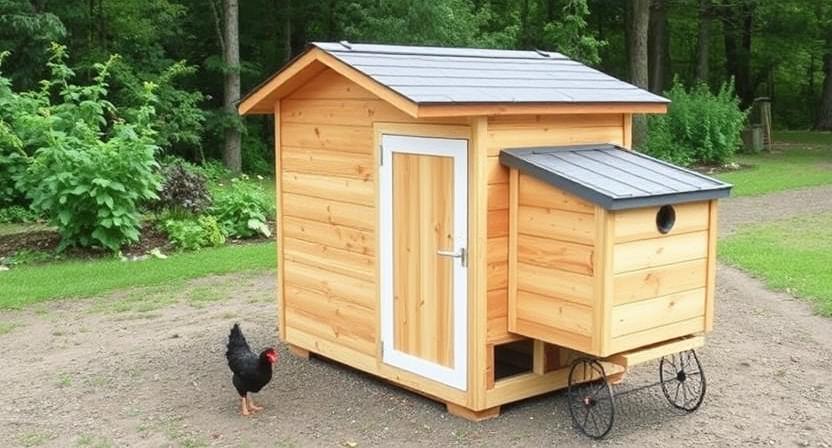How to Build Your Own Chicken Coop from Scratch

Materials Needed for Building a Chicken Coop
For building a chicken coop, you will need a variety of materials to ensure a sturdy and functional structure for your feathered friends. The essential materials include lumber for framing the coop, hardware cloth for secure walls, roofing materials for protection from the elements, as well as nails, screws, and hinges for assembly. Additionally, insulation materials, such as foam boards or fiberglass, will help regulate the temperature inside the coop and keep your chickens comfortable in varying weather conditions.
In addition to the main structural components, you will also need basic tools like a hammer, saw, drill, and measuring tape to assist in the construction process. Other necessary materials include exterior-grade paint or stain to protect the coop from moisture and prolong its lifespan, as well as nesting box materials, like plywood and straw, for your chickens to lay their eggs comfortably. With the right materials on hand, you can start building a safe and cozy home for your flock of chickens.
• Lumber for framing the coop
• Hardware cloth for secure walls
• Roofing materials for protection from elements
• Nails, screws, and hinges for assembly
• Insulation materials like foam boards or fiberglass
In addition to the main structural components, you will also need basic tools like a hammer, saw, drill, and measuring tape to assist in the construction process. Other necessary materials include exterior-grade paint or stain to protect the coop from moisture and prolong its lifespan, as well as nesting box materials like plywood and straw for your chickens to lay their eggs comfortably. With the right materials on hand, you can start building a safe and cozy home for your flock of chickens.
Choosing the Right Location for Your Chicken Coop
When selecting the ideal location for your chicken coop, it is essential to consider various factors that will contribute to the well-being and safety of your flock. Firstly, ensure that the chosen spot receives ample sunlight throughout the day to help keep the coop dry and warm. Chickens require natural light for their health and egg production, so a sunny location is preferred.
Additionally, it is crucial to pick a site that is well-drained to prevent flooding and water accumulation inside the coop. Soggy conditions can lead to health issues for your chickens and create a breeding ground for parasites and bacteria. A slightly elevated area with good drainage will help maintain a clean and healthy environment for your feathered friends.
• Choose a location that receives ample sunlight throughout the day
• Ensure the spot is well-drained to prevent flooding and water accumulation
• Opt for a slightly elevated area with good drainage for a clean and healthy environment
Designing the Layout and Size of Your Chicken Coop
When designing the layout and size of your chicken coop, it is important to consider the space needed for your flock to move around comfortably. The general rule of thumb is to allow for at least 2-4 square feet of coop space per chicken. This will ensure they have enough room to roost, nest, and move freely without feeling overcrowded.
Additionally, when planning the layout of your chicken coop, it is essential to include designated areas for nesting boxes, perches, feeders, and waterers. Nesting boxes should be placed in a quiet, secluded area to provide your hens with a safe and cozy space to lay their eggs. Perches should be positioned higher up in the coop to allow chickens to roost off the ground, which helps keep them safe from predators. Lastly, strategically placing feeders and waterers in accessible locations will make it easier for your chickens to access their food and water throughout the day.
• When designing the layout and size of your chicken coop, consider allowing for at least 2-4 square feet of coop space per chicken
• Ensure there is enough room for chickens to roost, nest, and move freely without feeling overcrowded
• Include designated areas for nesting boxes, perches, feeders, and waterers in the layout of your chicken coop
• Place nesting boxes in a quiet area to provide hens with a safe space to lay eggs
• Position perches higher up in the coop to allow chickens to roost off the ground and stay safe from predators
• Strategically place feeders and waterers in accessible locations for easy access throughout the day
Creating a Solid Foundation for Your Chicken Coop
When creating a solid foundation for your chicken coop, it is essential to start with a level surface. This will help ensure the stability and longevity of your coop. Clear the area of any debris, rocks, or vegetation that could disrupt the foundation.
Next, consider using materials such as concrete or treated lumber for your foundation. These materials will provide a sturdy base for your coop and help protect it from moisture and pests. Properly measure and layout the foundation to ensure it aligns with the dimensions of your coop design.
• Start with a level surface to ensure stability and longevity
• Clear the area of debris, rocks, or vegetation that could disrupt the foundation
• Consider using materials like concrete or treated lumber for a sturdy base
• Measure and layout the foundation to align with your coop design dimensions
Building the Frame of Your Chicken Coop
Once you have determined the layout and size of your chicken coop, the next step is to start building the frame. The frame serves as the skeleton of your coop, providing the structure and support for the walls, roof, and other components. It is essential to use sturdy materials such as pressure-treated lumber or metal framing to ensure the durability and longevity of your chicken coop.
Begin by constructing the base frame, which will form the foundation of your chicken coop. Make sure the corners are square and the frame is level before moving on to building the walls. Take accurate measurements and use appropriate tools to cut the lumber to the required dimensions. As you assemble the frame, secure the pieces together using screws, nails, or brackets for added stability. By creating a strong and well-built frame, you are laying a solid foundation for the rest of your chicken coop construction process.
• Once you have determined the layout and size of your chicken coop, the next step is to start building the frame.
• The frame serves as the skeleton of your coop, providing structure and support for walls, roof, and other components.
• It is essential to use sturdy materials such as pressure-treated lumber or metal framing for durability.
• Begin by constructing the base frame, ensuring corners are square and frame is level before moving on to walls.
• Take accurate measurements and use appropriate tools to cut lumber to required dimensions.
• Assemble the frame securely using screws, nails, or brackets for added stability.
Installing Walls and Roofs for Your Chicken Coop
Once the frame of your chicken coop is in place, the next step is to install the walls and roof to provide shelter and protection for your feathered friends. Choose durable and weather-resistant materials that will withstand the elements and keep your chickens safe and comfortable.
When installing the walls, ensure they are securely attached to the frame to prevent any gaps that could allow predators to enter. Opt for materials such as plywood or T1-11 siding that can provide insulation and protection from wind, rain, and snow. For the roof, consider using metal roofing or asphalt shingles for longevity and durability. Properly sealing all seams and edges will help to make your chicken coop watertight and cozy for your chickens.
• Securely attach walls to frame to prevent gaps
• Use plywood or T1-11 siding for insulation and protection
• Consider metal roofing or asphalt shingles for durability
• Seal all seams and edges for a watertight coop
Adding Windows and Ventilation to Your Chicken Coop
For proper ventilation in your chicken coop, it’s essential to incorporate windows that can be opened and closed as needed. Windows not only allow fresh air to circulate but also help regulate the temperature inside the coop. Ideally, windows should be placed higher up on the walls to promote good airflow without creating drafts directly on the chickens.
In addition to windows, providing vents near the roofline can further enhance ventilation by allowing hot air to escape, especially during the warmer months. These vents should be equipped with screens to prevent predators from entering while still allowing air to flow freely. Proper ventilation is crucial for maintaining a healthy environment for your chickens and minimizing the risk of respiratory issues caused by poor air quality in the coop.
• Windows should be placed higher up on the walls to promote good airflow
• Vents near the roofline can enhance ventilation during warmer months
• Screens should be installed on vents to prevent predators from entering
• Proper ventilation is crucial for maintaining a healthy environment for chickens
Constructing Doors for Easy Access to Your Chicken Coop
When constructing doors for your chicken coop, it is essential to consider both functionality and durability. The door should be large enough to allow easy access for cleaning, feeding, and gathering eggs, yet sturdy enough to keep predators out. Opt for materials such as treated wood or metal that can withstand the elements and potential wear and tear.
Additionally, ensure that the door is easy to open and close securely. Consider adding hinges and a latch that are both robust and user-friendly. A well-designed door will make daily tasks more convenient while also providing peace of mind that your chickens are safe and secure inside their coop.
• Choose a door size that allows easy access for cleaning, feeding, and egg collection
• Use durable materials like treated wood or metal to withstand weather and wear
• Install strong hinges and latch for security and ease of use
Building Nesting Boxes for Your Chickens to Lay Eggs
When building nesting boxes for your chickens to lay eggs, it is important to consider the size and design that will best accommodate your flock. Each nesting box should be spacious enough for a hen to comfortably enter, turn around, and feel secure while laying her eggs. A common rule of thumb is to provide one nesting box for every 3-4 hens to prevent overcrowding and competition for nesting space.
Additionally, choosing materials that are easy to clean and provide insulation for the eggs is essential. The nesting boxes should be lined with soft bedding, such as straw or wood shavings, to create a cozy and inviting environment for your hens to lay their eggs. Ensuring that the nesting boxes are located in a quiet and secluded area of the coop will also help to encourage your chickens to use them regularly for laying.
• Consider the size and design that will best accommodate your flock
• Provide one nesting box for every 3-4 hens to prevent overcrowding
• Choose materials that are easy to clean and provide insulation for eggs
• Line nesting boxes with soft bedding like straw or wood shavings
• Locate nesting boxes in a quiet and secluded area of the coop
Installing Perches for Your Chickens to Roost
When installing perches for your chickens to roost, it’s essential to consider their natural roosting behavior. Chickens typically prefer roosting on elevated structures to feel safe and secure during the night. Provide sturdy perches that are at least 2 inches wide to allow for comfortable roosting for your chickens. Place the perches away from nesting boxes to prevent any droppings from falling into the nests.
Additionally, ensure that the perches are installed at a height of around 2 to 4 feet above the ground, allowing enough space for the chickens to easily hop onto them. Consider varying the heights of the perches to accommodate different preferences among your flock. Remember to regularly clean the perches to maintain a hygienic roosting environment for your chickens.
• Consider the natural roosting behavior of chickens
• Provide sturdy perches that are at least 2 inches wide
• Place perches away from nesting boxes to prevent droppings in nests
• Install perches at a height of 2 to 4 feet above the ground
• Vary heights of perches to accommodate different preferences among flock
• Regularly clean perches for hygienic roosting environment
Setting Up Feeders and Waterers Inside Your Chicken Coop
Feeders and waterers are essential components of a well-functioning chicken coop. When setting up these items, it is important to consider the number of chickens you have to ensure there is enough space for each bird to access food and water easily. Make sure the feeders are secured in place to prevent spillage or contamination from the coop bedding.
Waterers should be placed in a location where they are easily accessible to the chickens but are not in a spot where they can easily be knocked over or soiled. Be sure to clean and refill the waterers regularly to ensure a fresh and clean water supply for your chickens. Additionally, consider using gravity-fed or automatic waterers to make the process more efficient and hassle-free for both you and your feathered friends.
– Secure feeders in place to prevent spillage or contamination
– Ensure enough space for each bird to access food and water easily
– Clean and refill waterers regularly for fresh supply
– Place waterers in accessible location but not easily knocked over or soiled
– Consider using gravity-fed or automatic waterers for efficiency
Adding Insulation to Keep Your Chickens Warm in Winter
Insulating your chicken coop is essential to keeping your feathered friends warm and comfortable during the cold winter months. Proper insulation helps regulate the temperature inside the coop, preventing drafts and maintaining a cozy environment for the chickens. Consider using materials such as fiberglass batts, foam boards, or reflective insulation to ensure effective heat retention.
When adding insulation to your chicken coop, focus on covering walls, ceiling, and even the floor if possible. Pay close attention to sealing any gaps or cracks in the coop to prevent heat from escaping. By insulating thoroughly and strategically, you can create a snug space that promotes the well-being and health of your chickens even when the temperatures drop.
• Insulating your chicken coop is crucial for keeping chickens warm in winter
• Materials like fiberglass batts, foam boards, or reflective insulation are effective options
• Focus on insulating walls, ceiling, and floor of the coop
• Seal any gaps or cracks to prevent heat from escaping
• Creating a snug space promotes well-being and health of chickens during cold temperatures
Ensuring Proper Lighting Inside Your Chicken Coop
For ensuring proper lighting inside your chicken coop, it’s essential to provide natural light during the day to mimic the chickens’ natural environment. Make sure to place windows strategically to allow sunlight to enter the coop. Additionally, consider installing artificial lighting to supplement natural light, especially during the winter months when daylight hours are shorter. This will help maintain a consistent light cycle for the chickens, promoting their overall health and egg production.
When choosing lighting fixtures for your chicken coop, opt for options that are safe, durable, and energy-efficient. LED lights are a popular choice as they provide bright illumination while being cost-effective in the long run. Position the lights in a way that evenly distributes light throughout the coop, ensuring that all areas are well-lit. Remember to regularly check and maintain the lights to ensure they are functioning properly and to avoid any disruptions to the chickens’ light exposure.
• Position windows strategically to allow natural light into the coop
• Consider installing artificial lighting to supplement natural light, especially in winter
• Choose safe, durable, and energy-efficient lighting fixtures for the coop
• Opt for LED lights for bright illumination and cost-effectiveness
• Ensure lights are evenly distributed throughout the coop
• Regularly check and maintain lighting fixtures to avoid disruptions
Securing Your Chicken Coop Against Predators
To keep your chickens safe from predators, it is essential to employ multiple layers of protection around your coop. Start by ensuring that the coop itself is sturdy and predator-proof. Use heavy-duty materials for the walls and roof that cannot be easily breached by predators such as raccoons, foxes, or even neighborhood dogs. Additionally, make sure that windows and doors are securely fastened and cannot be opened from the outside. Consider installing locks or latches for added security.
In addition to fortifying the coop itself, it is important to create a secure perimeter around the coop area. This can be achieved by installing fencing underground to prevent digging predators from gaining access. Surround the coop with a tall fence that is difficult to climb or jump over. Make sure to regularly inspect the perimeter for any signs of weakness or potential entry points for predators. By implementing these protective measures, you can help ensure the safety and well-being of your feathered friends.
• Use heavy-duty materials for walls and roof
• Securely fasten windows and doors
• Consider installing locks or latches for added security
• Install underground fencing to prevent digging predators
• Surround coop with a tall fence that is difficult to climb or jump over
• Regularly inspect perimeter for signs of weakness
Installing a Run Area for Your Chickens to Exercise
To provide your chickens with ample space for exercise, it is essential to have a well-designed run area attached to their coop. This run area should be securely fenced to prevent predators from gaining access and should have a solid roof or netting to protect the chickens from aerial threats. Additionally, it is important to ensure that the flooring of the run area is appropriate for the chickens’ feet, such as grass, dirt, or gravel.
Aim for at least 8 square feet of space per chicken in the run area to allow them to move around freely and engage in natural behaviors like foraging and dust bathing. Providing environmental enrichment such as perches, logs, or hiding spots can also encourage physical activity and mental stimulation for your chickens. Regularly monitoring the condition of the run area and ensuring that it remains clean and free of any hazards will help promote the health and well-being of your flock.
• Aim for at least 8 square feet of space per chicken in the run area
• Ensure the run area is securely fenced to prevent predators from gaining access
• Have a solid roof or netting to protect chickens from aerial threats
• Use appropriate flooring such as grass, dirt, or gravel for the chickens’ feet
• Provide environmental enrichment like perches, logs, or hiding spots for physical activity and mental stimulation
• Regularly monitor and clean the run area to promote the health and well-being of your flock
Adding a Dust Bath Area for Your Chickens’ Health
Dust bathing is a natural behavior for chickens that helps them maintain good health and hygiene. Providing a designated dust bath area in your chicken coop is essential for allowing your chickens to engage in this behavior.
To create a dust bath area, you can use a shallow container or box filled with fine dusting material such as sand, wood ash, or diatomaceous earth. Place the dust bath area in a dry and shaded spot within the coop where your chickens can access it easily. Observing your chickens enjoying their dust bathing routine can be a satisfying experience as you witness them taking care of their own cleanliness and well-being.
Creating a dust bath area for your chickens is simple and beneficial for their health. Here are some key points to keep in mind:
• Choose a shallow container or box to use as the dust bath area
• Fill it with fine dusting material like sand, wood ash, or diatomaceous earth
• Place the dust bath area in a dry and shaded spot within the chicken coop
• Ensure easy access for your chickens to use the designated dust bathing area
By providing a proper space for your chickens to engage in this natural behavior, you are promoting good hygiene and overall well-being among your flock. Dust bathing helps control pests, keeps feathers clean, and provides entertainment for your feathered friends. Make sure to maintain and replenish the dusting material regularly to keep the area effective for your chickens’ health needs.
Implementing a Waste Management System for Your Chicken Coop
One crucial aspect of maintaining a healthy and clean environment in your chicken coop is implementing an effective waste management system. Ensuring proper disposal of waste not only promotes better hygiene but also helps in preventing the spread of diseases among your flock.
Make sure to regularly remove soiled bedding, droppings, and any other waste material from the coop. Consider composting the waste for use as fertilizer in your garden or disposing of it safely away from areas where your chickens roam. Additionally, incorporating a deep litter system can aid in breaking down waste naturally while also providing insulation and creating a more comfortable environment for your chickens.
– Regularly remove soiled bedding, droppings, and waste material from the coop
– Consider composting waste for use as fertilizer or dispose of it safely away from chicken roaming areas
– Implement a deep litter system to aid in breaking down waste naturally
– Deep litter system also provides insulation and creates a comfortable environment for chickens
Maintaining Cleanliness and Hygiene in Your Chicken Coop
Maintaining a clean and hygienic environment in your chicken coop is crucial for the health and well-being of your feathered friends. Regular cleaning and removal of droppings, soiled bedding, and feed spills help prevent the buildup of bacteria and parasites that can harm your chickens. Make it a habit to clean your chicken coop at least once a week, paying particular attention to areas where moisture can accumulate.
Additionally, providing proper ventilation in your chicken coop can help reduce ammonia levels and moisture, which can lead to respiratory issues and other health problems in chickens. Ensure that your coop has adequate airflow by installing windows and vents that can be opened and closed as needed. Good ventilation not only keeps the air fresh but also helps control humidity levels, creating a healthier environment for your flock.
• Regular cleaning and removal of droppings, soiled bedding, and feed spills is crucial
• Clean your chicken coop at least once a week
• Pay particular attention to areas where moisture can accumulate
• Provide proper ventilation in your chicken coop to reduce ammonia levels and moisture
• Ensure adequate airflow by installing windows and vents that can be opened and closed as needed
• Good ventilation helps control humidity levels and creates a healthier environment for your flock
Monitoring Your Chickens’ Health and Well-being
Monitoring your chickens’ health and well-being is essential to ensuring they lead happy and healthy lives. Regularly observing your chickens for any signs of illness or distress is key. Look out for changes in behavior, such as decreased activity or appetite, as these could indicate underlying health issues. Additionally, checking their physical appearance for any abnormalities like injuries or parasites is important in maintaining their well-being.
Another aspect of monitoring your chickens’ health is keeping track of their egg production and quality. A sudden decrease in egg production or changes in the appearance of the eggs can signal health problems in your flock. Monitoring the cleanliness of the coop and nesting boxes is also crucial to prevent the spread of diseases and maintain a hygienic environment for your chickens. By staying vigilant and attentive to their needs, you can ensure that your chickens stay healthy and happy.
• Regularly observe your chickens for signs of illness or distress
• Look out for changes in behavior, such as decreased activity or appetite
• Check their physical appearance for abnormalities like injuries or parasites
• Keep track of egg production and quality to monitor health status
• Monitor cleanliness of coop and nesting boxes to prevent diseases
Enriching Your Chickens’ Environment for Their Mental Stimulation
Chickens are intelligent and curious creatures that benefit from mental stimulation to keep them happy and healthy. One way to enrich their environment is by providing them with various forms of entertainment. You can introduce hanging treats for them to peck at, which not only engages their minds but also encourages natural foraging behavior. Additionally, setting up a chicken-friendly obstacle course or placing mirrors in their coop can pique their interest and provide mental challenges.
Another way to stimulate your chickens’ minds is by rotating their toys and activities regularly. This can prevent boredom and keep them actively exploring their surroundings. Simple objects like a ball for them to push around or a tethered corn cob for pecking can offer hours of entertainment. By incorporating a variety of stimulating activities into their daily routine, you can ensure that your chickens lead fulfilling and enriched lives.
• Providing hanging treats for chickens to peck at
• Setting up a chicken-friendly obstacle course
• Placing mirrors in their coop for mental stimulation
Rotating toys and activities regularly:
• Prevents boredom
• Keeps chickens actively exploring surroundings
• Simple objects like balls or tethered corn cobs can offer entertainment
Incorporating a variety of stimulating activities into daily routine:
• Ensures chickens lead fulfilling lives
• Promotes mental enrichment and overall well-being




